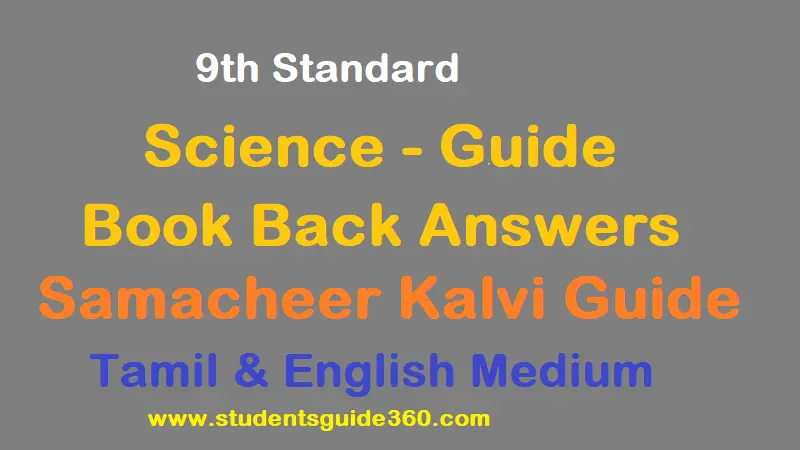9th Science Guide Unite 10 Matter around us
9th Std Science Lesson 10 Matter around us – English Medium Guide
9th Science Book Back Answers Unit 10. 9th Science Lesson 10 Matter around us Book Back Answers. 9th Standard Science Samacheer kalvi Guide Book Back Answers download PDF Tamil Medium and English Medium book in answers. 9th All Subject Guide. Class 9 Science Questions and Answers. Class 1 to 12 All Subject Guide.

9th Science Guide Unite 10 Matter around us
EXERCISE 1
I. Choose the correct answer:
1. The physical state of water at 373 K is _____________
- Solid
- liquid
- vapour
- plasma
Ans : vapour
2. Among the following ___________ is a mixture
- Common Salt
- Juice
- Carbon dioxide
- Pure Silver
Ans : Juice
3. When we mix a drop of ink in water we get a ________________
- Heterogeneous Mixture
- Homogeneous Mixture
- Compound
- Suspension
Ans : Homogeneous Mixture
4. The constituents that form a mixture are also called
- Elements
- Compounds
- Alloys
- Components
Ans : Components
5. __________ has the same properties throughout the sample
- Pure substance
- Mixture
- Colloid
- Suspension
Ans : Pure substance
II. State whether the following statements are True or False. If false give the correct statement.
- Liquids expand more than gases on heating. ( False )
Ans : Gases expand considerably on heating.
- A compound cannot be broken into simpler substances chemically. ( False )
Ans : can be spitted into new substances by chemical methods.
- Water has a definite boiling point and freezing point. ( Ture )
- Buttermilk is an example of heterogeneous mixture. ( Ture )
- Aspirin is composed of 60% Carbon, 4.5% Hydrogen and 35.5% Oxygen by mass. Aspirin is a
mixture. ( False )
Ans : Aspirin is a compound.
III. A. Match the following:
- Element – Settles down on standing.
- Compound – Impure substance
- Colloid – Made up of molecules
- Suspension – pure substance
- Mixture – Made up of atoms
Ans : 1 – E, 2 – D, 3 – C, 4 – A, 5 – B
IV. Fill in the blanks:
- Evaporation is always accompanied by __________ in temperature.
Ans : decrease
- 150oC = ________K Ans : 423
- A _____________ mixture has no distinguishable boundary between its components.
Ans : homogeneous
- An example of a substance that sublimes is _________
Ans : naphthalene
- Latent heat is the energy used for ________
Ans : inter conversion of matter
V. Short answer:
1. Why is it possible to row a boat in water but not pass through a wooden fence.
There are gaps between the molecules of water.
2. How does gaseous pressure arise?
The rapid motion and collision of molecules with the walls of the container causes pressure.
3. Define sublimation?
The process of conversion of matter from solid state directly into vapour state (without going to liquid state).
4. Which state of matter has the highest kinetic energy?
Gaseous state of matter.
5. A few drops of ‘dettol’ when added to water the mixture turns turbid. Why?
The oil droplets of dettol get suspended in water and create an emulsion.
VI. Short answer:
1.Why are gases easily compressible whereas solids are incompressible?
The atoms and molecules in gases are much more spread out than in solids or liquids. They move freely and vibrate freely at high speed.
2. Hold a ‘Smiley ball’ and squeeze it can you compress it? Justify your answer.
A smiley ball has minute holes, in which air is trapped. When we press it the air is expelled out. So we are able to compress.
3. Which of the following are pure substances? Ice, Milk, Iron, Hydrochloric acid, Mercury, Brick and water
Iron, Hydrochloric acid, Mercury and water.
4. Oxygen is very essential for us to live. If forms 21% of air by volume. Is it at element or compound?
it is an element.
5. You have just won a medal made of 24-carat gold. Have you just procured a pure substance or impure substance?
A pure substance. Because, it is an alloy.
9th Science Guide Unite 10 Matter around us
EXERCISE 2
I. Choose the correct answer
1. Difference in ________________ is the principle used in fractional distillation
- solubility
- melting point
- boiling point
- adsorption
Ans : boiling point
2. The separation of denser particles from lighter particles done by rotation at high speed is called _____________
- Filtration
- sedimentation
- decantation
- centrifugation
Ans : centrifugation
3. _________ is essential to perform separation by solvent extraction method.
- Separating funnel
- centrifuge machine
- filter paper
- sieve
Ans : Separating funnel
4. Filtration method is effective in separating _________ mixture
- Solid-solid
- solid-liquid
- liquid-liquid
- liquid-gas
Ans : solid-liquid
5. For a simple distillation process we need to have
- an evaporating dish.
- a separating funnel.
- a filter with filter paper.
- a Liebig condenser.
Ans : a Liebig condenser.
II. State whether the following statements are true or false. If false give the correct statement
- Butter from curd be separated by centrifugation. ( Ture )
- Oil and water are immiscible in each other. ( Ture )
- Sublimation is the property of a substance to directly change from liquid to solid state. ( False )
Ans : change from solid to vapour.
- Liquid – liquid colloids are called gels. ( False )
Ans: Liquid – liquid colloids are called emulsions.
- Fractional distillation is used when the boiling point of the components have large difference. ( False )
Ans : Simple distillation is used when the bp of the components have large difference.
III. Match the following
|
1. Sand and camphor |
Ink |
Distillation |
|
2. Acetone and water |
Miscible liquids |
Chromatography |
|
3. Pigments |
Immiscible liquids |
Separating funnel |
|
4. Salt and water |
Mixture of two solids |
Fractional distillation |
|
5. Water and kerosene |
Soluble |
Sublimation |
|
Ans : 1 – D – E, 2 – B – D, 3 – A – B, 4 – E – A, 5 – C – C |
||
IV. Fill in the blanks
- Alcohol can be separated from water by ____________Ans : Distillation
- Sand is removed from naphthalene by __________ method.
Ans : Sublimation
- In petroleum refining, the method of separation used is ______________
Ans : Fractional distillation
- Chromatography is based on the principle of ________ Ans : Adsorption
- The solubility of solid in water ___________ with an increase in temperature.
Ans : increases
V. Very Short answer
1. Name the method you would adopt to separate a mixture of ammonium chloride and common salt.
Sublimation
2. Define a solute and solvent?
Solute is the component present in smaller proportion in a solution/ Solvent is the component present in larger proportion in a solution.
3. Name the sublimate that you will be getting when you heat a mixture of i) iodine and sand ii) sodium chloride and ammonium chloride.
- i) Iodine ii) Ammonium chloride.
4. What is meant by desalination of sea water?
The technique used to obtain drinking water from salt water is called desalination.
VI. Short answer
1. What is an adsorbate and adsorbent?
Adsorbate is a substance which gets adsorbed (adhered) to a surface of another substance. Adsorbent is a substance which adsorbs another substance on its surface.
Example: Charcoal adsorbs gases on its surface. (charcoal – adsorbent, gas-adsorbate).
2. What is meant by Rf value?
Rf value is the ration of the distance travelled by the solute to the distance travelled by the solvent.
That is Rf = Distance travelled by the solute / Distance travelled by the solvent
3. Differentiate between filtrate and distillate.
- Filtrate – The clear liquid which passes through the filter paper after filtration is called filtrate.
- Distillate: The clear liquid which evaporates and then condenses during distillation is called distillate.
4. Name the apparatus that you will use to separate the components of mixtures containing two i) miscible liquids ii) immiscible liquids.
- i) ‘Liebig’ condenser ii) Separating funnel
5. How will you separate a mixture containing saw dust, naphthalene and iron fillings?
By using magnetic separation iron filters can be removed from saw dust and naphthalene. By using sublimation process, we can separate naphthalene from saw dust.



